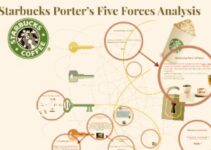Sports Apparel outlines various types of clothing for performing physical exercises like yoga, running, hiking, and swimming. The sportswear companies manufacture a wide range of clothing items for men, women, and children. Today, we’ll discuss Porter’s five forces analysis of Sports Apparel industry; bargaining power of suppliers and buyers; threat of new entrants and substitutes; and intense rivalry as competitive forces in strategic management.
Sports Apparel Includes the Following
- Shorts
- Tops
- Trousers
- Shirts
- T-shirts
- Tights
Substitutes and Competitive Companies in the Sports Apparel Industry
- Mizuno
- Asics
- Columbia Sportswear
- Puma
- LI Ning
- Reebok
- Adidas
- Nike
Porter’s five forces analysis of Sports Apparel industry would analyze the bargaining power of suppliers and buyers; the threat of new entrants and substitutes; and intense rivalry as competitive forces in strategic management. Here’s Sports Apparel industry Porter’s five forces analysis of sportswear business as follows;
Porter’s Five Forces Analysis of Sports Apparel Industry
Let’s discuss Porter’s five forces analysis of Sports Apparel Industry as competitive forces in strategic management and they’re as follows;
Bargaining Power of Suppliers in Sports Apparel Industry
The bargaining of suppliers is low in the Sports Apparel Industry as competitive forces in strategic management. Some of the main factors impacting the bargaining power of suppliers in the Sports Apparel Industry Porter’s five forces analysis of sportswear business are as follows;
I-Sports Apparel Material
The materials and supplies used for the production and manufacturing of Sports Apparel are as follows;
- Spandex
- Nylon
- Polyester
- Polar fleece
- Stretch fabric
- Gore-tex
- Textile
The suppliers of Sports Apparel materials are easily and conveniently available in various countries across the world. If one supplier increases the price of material; sports apparel manufacturers would choose the other supplier without incurring any cost.
II-Long Term Contracts with Sports Brands
The vast variety of suppliers decreases their bargaining power. In order to ensure the smooth supply and sale of materials; suppliers build long-term contracts with the leading sportswear brands like Nike, Adidas, and Puma. It is mutually beneficial for both brands; suppliers don’t have to look for new clients every time they produce cotton material; and brands receive a smooth supply of raw material.
Bargaining Power of Buyers in Sports Apparel Industry
The bargaining of Buyers is low in the Sports Apparel business as competitive forces in strategic management. Some of the main factors impacting the bargaining power of suppliers in the Sports Apparel business five forces analysis of the Sports Apparel industry are as follows;
I-Brand & Quality
While shopping for Sports Apparel; customers have limited bargaining power. There is no doubt, there are multiple sportswear brands both premium and low-cost; the price impacts the quality of the product. When customers switch from one sportswear brand to another, then they experience a significant amount of quality difference.
II-Counterfeit Items
Along with top leading brands, there are many counterfeiting brands available in the market. They deceive customers by disguising it as a top brand, but in reality, there is nothing but a cheap copy counterfeit. However, the counterfeit brand option has made sports customers highly cautious about the quality and the brand. Some of the new users become deceived by the cheap counterfeits.
Threat of New Entrants in Sports Apparel Industry
The threat of new entrants is low in the sportswear business and Sports Apparel industry as competitive forces in strategic management. Some of the main factors impacting the threat of new entrants in the sportswear business five forces analysis of Sports Apparel industry are as follows;
I-Tech Innovation & Investment
Sports Apparel manufacturing brands invest a significant amount of capital resources in the development of unique materials that are comfortable and top quality. Along with tech innovation, mass-scale production requires heavy investment in industrial equipment, machinery, designing, and other resources.
II-Banding & Marketing
Along with heavy investment, existing Sports Apparel companies have established a very loyal database of customers with decades of marketing, promotion, and branding. They run various types of marketing and promotional campaigns to attract and retain the attention of customers. The new brands won’t have the budget and resources to run worldwide marketing campaigns.
Threat of Substitutes to Sports Apparel Industry
The threat of substitute products and brands is higher in the Sports Apparel industry as competitive forces in strategic management. Some of the main factors impacting the threat of new substitutes in the sportswear business 5 forces analysis of Sports Apparel industry are as follows;
I-Alternative Sports Brands
There are multiple Sports Apparel brands operating their business in the sportswear industry. Customers could easily switch from one sports apparel brand to another without incurring any cost. The premium brands offer almost the same type of material and quality; customers want to try something new and different every time they shop.
II-Low Cost Options
Along with premium quality brands, there are also low-cost Sports Apparel companies that offer reasonable quality sportswear items at an affordable price range. The price-conscious customers would choose the affordable price options relevant to their purchasing power.
Competitive Rivalry in Sports Apparel Industry
The competitive rivalry among Sports companies is very high in the Sports Apparel industry as competitive forces in strategic management. Some of the main factors impacting competitive rivalry in the Sports Apparel business five forces analysis of sportswear business are as follows;
I-Tough Competition
The sports apparel industry has become highly competitive over the years. Adidas, Nike, Lululemon, and Asics are the top sports apparel manufacturing companies. They have earned a significant market share in the global sportswear industry. Their market presence has made the sportswear market saturated with multiple sportswear alternatives and options.
In order to gain a competitive edge over competitors; they invest a significant amount of capital resources on research for developing the latest designs; unique designs, and comfortable material apparel for athletes and sportsmen.
Conclusion: Sports Apparel Industry Porter’s Five Forces Analysis |5 Forces Analysis of Sports Apparel Industry
After an in-depth study of Porter’s five forces analysis of Sports Apparel industry; we have realized that sportswear business is growing exponentially. If you are learning about the Sports Apparel industry 5 forces analysis of sportswear business; then you should keep in mind the abovementioned bargaining power of suppliers and buyers; threat of new entrants and substitutes; and intense rivalry as competitive forces in strategic management.

Ahsan is an accomplished researcher and has a deep insight in worldly life affairs. He goes Live 3 days a week on various social media platforms. Other than research writing, he’s a very interesting person.


